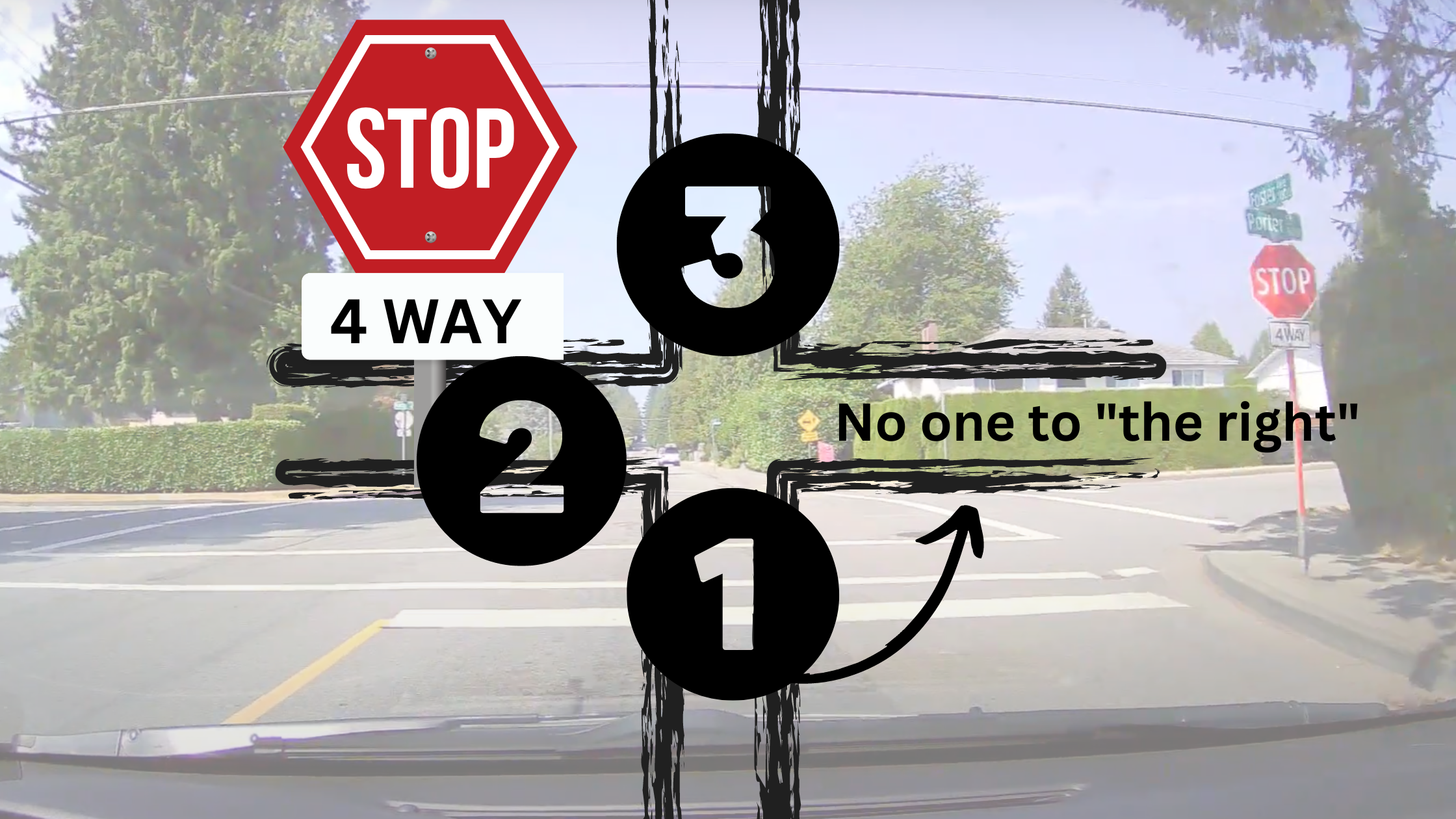What is the 4-Way Stop Intersection in North America?
The 4-way stop is a type of intersection where all drivers must stop completely, and then take turns in order of arrival. These intersections aren’t found worldwide. They’re mostly found in North America in Canada and the U.S.
If you are confused by them, you’re not the only one; but don’t worry. We will go through how this intersection is supposed to work, and some tips and tricks for dealing with them. Check out my 4-way stops playlist on YouTube.
Four-Way Stop Rules
- Whoever stops first, should go first
- Whoever stops second, goes second (and third, and so on)
- If you stop at the same time, yield to the right
- And, if you stop at the same time, left-turning traffic should yield to straight-through and right-turning traffic
- All drivers must yield to pedestrians
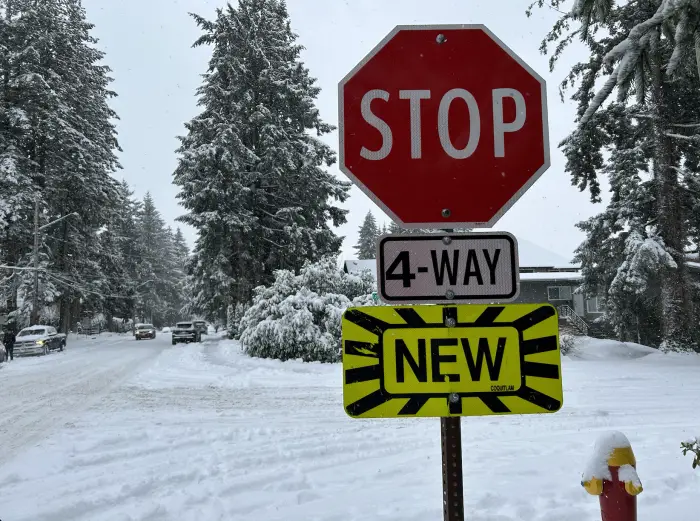
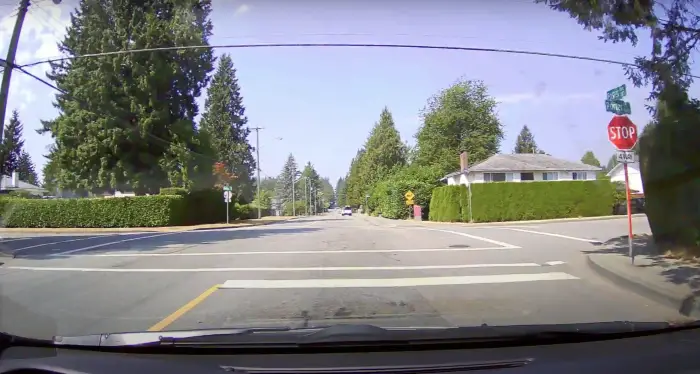
4-Way Stops, 3-Way Stops, 5-Way Stops, All-Way Stop Intersections
These all work the same
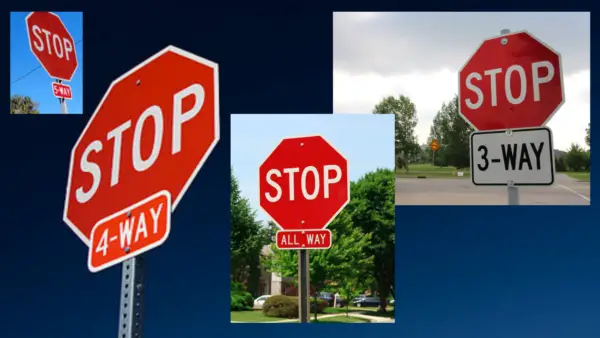
You may encounter a 4-way stop, 3-way stop, 5-way stop, or an “all-way” stop. These all work exactly the same; it’s just that there may or may not be exactly 4 directions. For any of these intersections, all drivers must stop and then take turns.
How to identify the 4-way-stop intersection
The 4-way stop (and the other intersections like 3-way, 5-way, all way stops) commonly have a tab on the bottom of the sign. This is so you can easily identify the intersection as a 4-way stop, rather than a ‘normal’ stop sign such as a 2-way stop.
You aren’t normally expected to count other drivers’ stop signs while driving, but sometimes this is necessary. This tab makes life easier to understand.
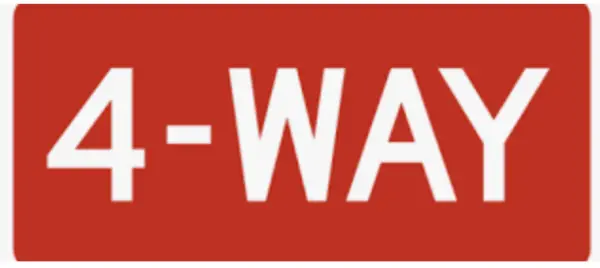
Two-way stops may or may not also have a tab, but they usually don’t. 2-way stops are different in that 2 directions of travel must stop and yield to the 2 other directions of travel, which do not stop.
Look for the backs of signs for the other traffic to be certain what type of intersection you are at before assuming.
4-Way Stop Sign Technique For Driving
What I basically do when coming up to a 4-way stop, is I just come to a complete stop and I take a look at which other vehicles stopped before mine. If they stopped before me, they should go before me, and then I should take my turn.
Three Cars Arrive at a Four-Way Stop at the Same Time – Who Should Go First?
If three cars arrive at a 4-way stop at the same time, drivers should be yielding to the right. In other words, one of the cars will have no other vehicle to his or her right, so, that driver would be the one to go first. After that, whichever car has no car to the right would go next.
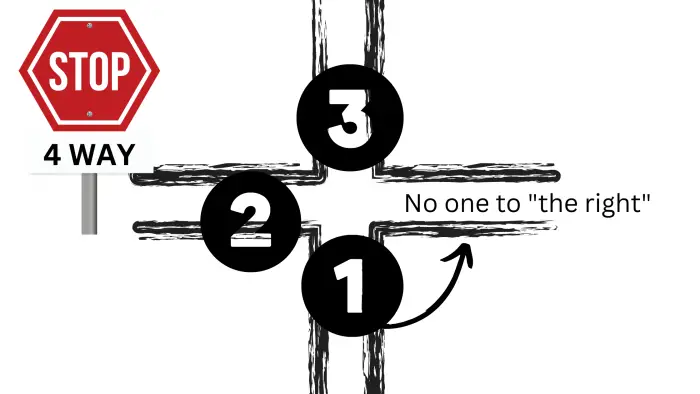
Why Do We Yield To The Right?
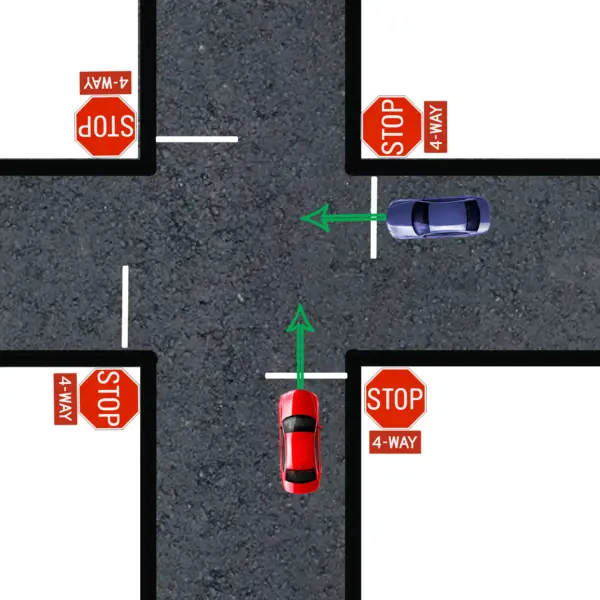
There’s a reason why we yield to the right and not the left when we are driving at 4-way stops and other intersections. Yielding to the right clears the intersection faster; it’s the most efficient way to keep everyone moving through.
This is because we drive on the right half of the road. When the car on the right goes first, it travels only halfway across the road before it is out of your way.
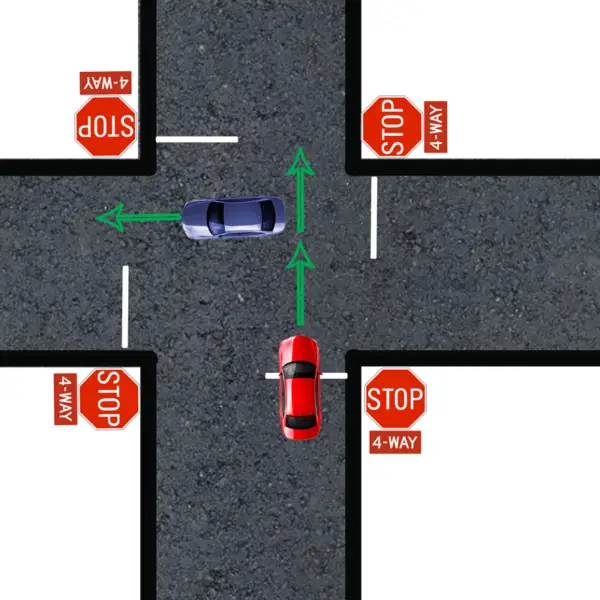
If the car on the left moves first, it will have to travel across the entire intersection before being out of the way of the other vehicle. The other vehicle will need to remain completely stopped for longer.
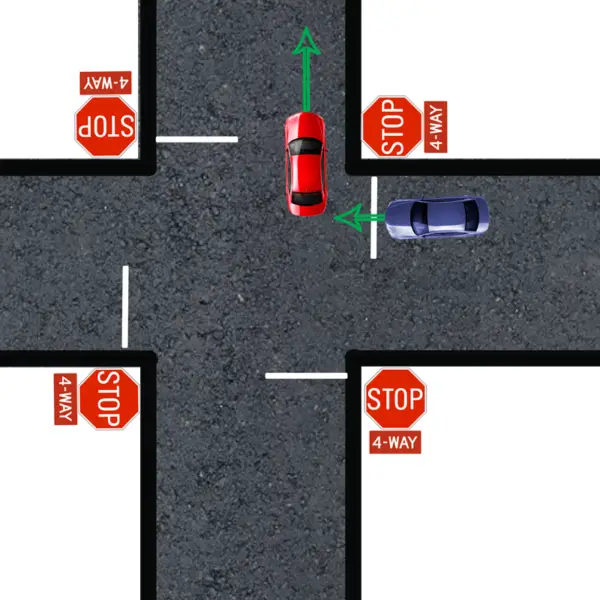
And since the point of driving is to like, get somewhere, this is a good system that keeps things moving in an efficient kind of way.
4-Way Stop – If You’re On The Left
If you are situated on the left at a 4-way stop, start moving when the first car is out of your way (hesitate only if the car is turning left). You do not have to watch the driver disappear over the horizon before you start moving.
Be assertive so that cars arriving after you will not be confused. This means taking your foot off the brake and letting your car begin to roll when you know it is your turn.
Other drivers will then know you are getting ready to go. If you hesitate, other drivers may think you’re yielding to them, and your 4-way stop can quickly turn into a confusing thing.
4-Way Stop If You Stop At The Same Time
If you stop at the same time as another car at a 4-way stop, left-turning drivers should yield to drivers going straight.
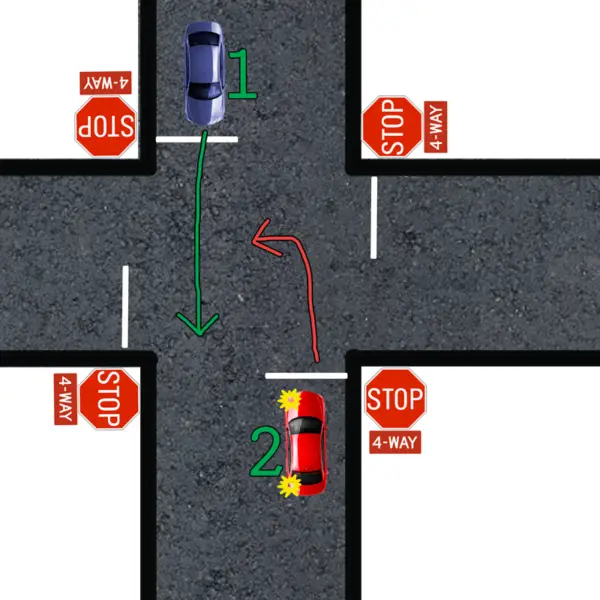
Also, left-turning drivers should yield to right-turning drivers. This allows the intersection to clear as quickly as possible. These two cars can actually turn almost at the exact same time and not have a collision, just because the right turn is so much smaller than the left.
Just think of it this way: If you stop at the same time, yield to whoever is on the right, and those who are turning right.
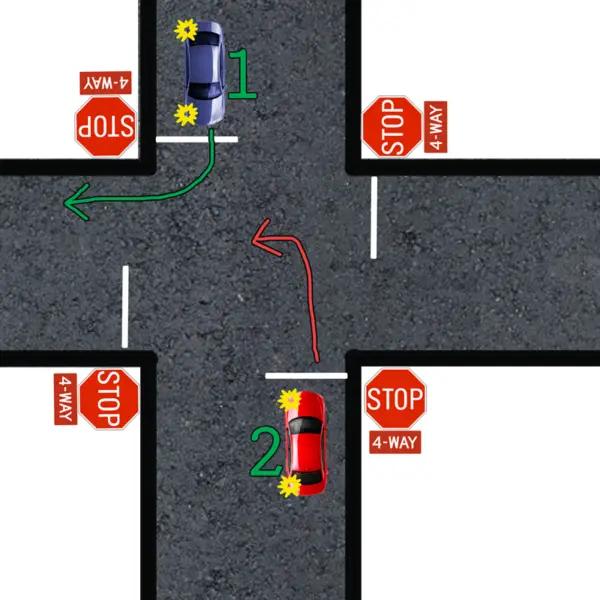
You may be able to go at the same time if you are both going straight and facing each other

Or if you are both turning left and facing each other

This is only safe as long as you know 100% that the other driver is going to follow through with what their signal – or lack of a signal – indicates. Use caution and make sure the next move is obvious. Hesitate if you aren’t sure.
There have been collisions at 4-way stops because someone simply thought someone else was going to turn (or go straight, whatever) and they did something different.
So it’s really important to make sure the other vehicles are actually going where you think they are. This can be tricky sometimes. If you’re ever not sure, just wait until it’s obviously safe and then take your turn.
If you are both turning right, or if all vehicles are turning right, normally you could go at the same time.
This is because there’s no potential conflict over the use of the same chunk of pavement
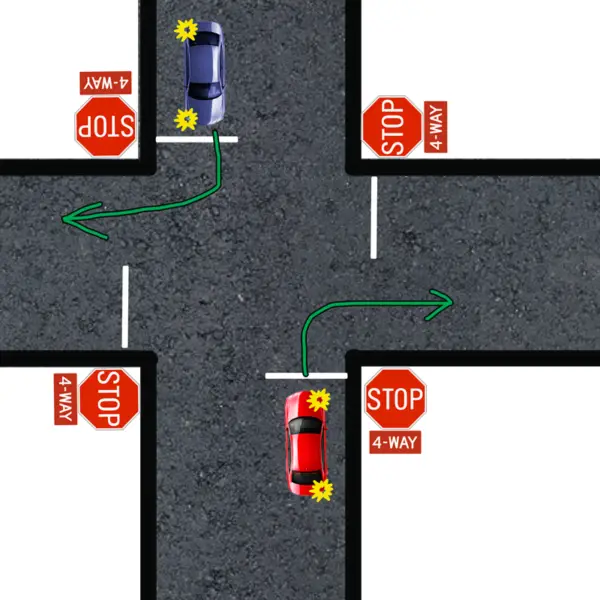
This only works safely if the road isn’t too narrow, and there is a shared certainty of expected movement.
Pedestrians At The 4-Way Stop
Pedestrians can confuse drivers in the 4-way stop just as they can confuse the two-way stop. All drivers must yield to pedestrians first.
If it is not your turn to go, and other vehicles are being stopped by pedestrians crossing, you could take the right of way when it is obviously safe to do so. Why not?
If you’re not sure or don’t feel comfortable going, then simply yield (remain completely stopped) and the other driver will take a hint.
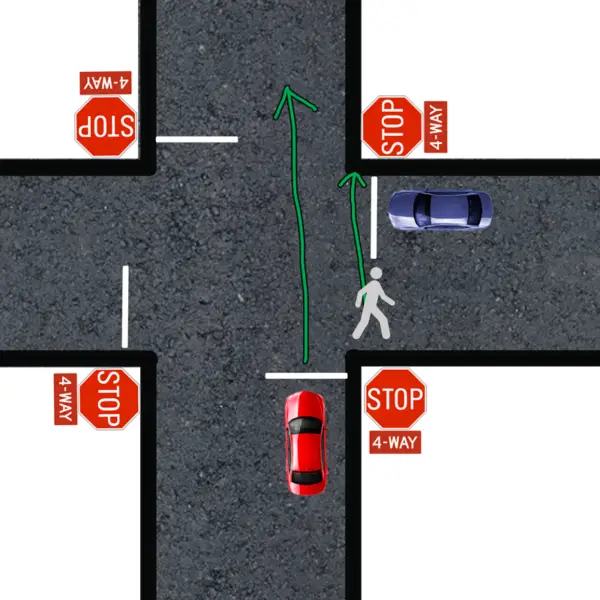
Four Cars Arrive at a Four-Way Stop at The Same Time – Who Should Go First?
If four cars arrive at the same time at a 4-way stop, who should go? This doesn’t happen very often. Show courtesy and look at the intended direction of each vehicle’s turn. If all drivers want to go straight, the problem is greater than if they all want to turn right.
Keep in mind, that you control the speed of your vehicle. If you see three other cars approaching at almost the same time, you could approach the intersection slower than the others and be the last to stop in order to avoid confusion.
I personally do this sometimes just to make my life easier. I slow down more slowly than the other cars, arrive after them, and go 4th. It’s just easier on my brain. And I’m not in that much of a hurry that I need to be the one to go first.
Make Eye Contact At 4-Way Stops
Whenever Possible
Always establish eye contact with other drivers at a four-way stop whenever this is available. When you have eye contact, check the other roads for a driver that might be about to run through the intersection without noticing the stop sign.
Drivers don’t – on purpose – hit things they can see, but might hit you if they don’t see the stop sign. This means the most dangerous area at a 4-way stop is usually the direction where you don’t, – haven’t, or can’t – see a car; not from drivers who already see you and have stopped.
Someone might drive through the intersection at any given rate of speed if they don’t see the stop sign or intersection. Don’t be anxious, but do check and be prepared to act.
Realize that there are other ways to avoid collisions besides slowing down or slamming on your brakes. In certain instances, you could avoid collisions by speeding up to get out of the way. I have done this in my life.
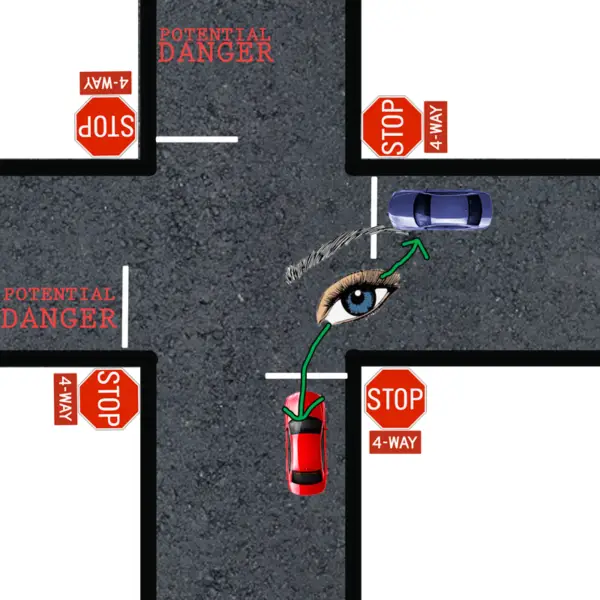
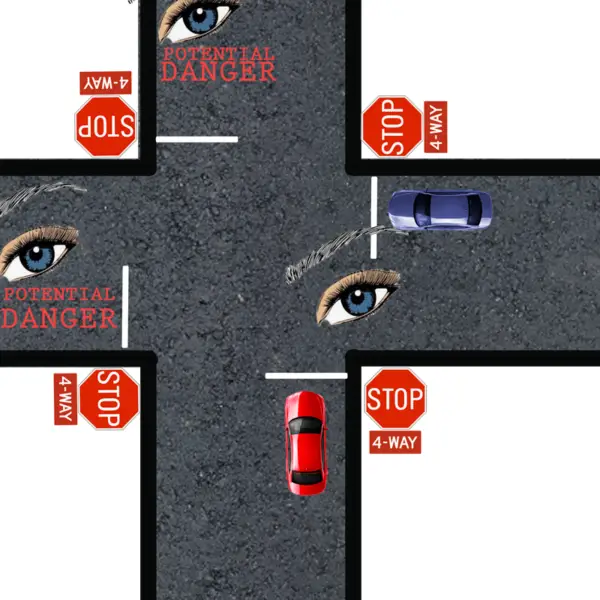
Avoid Confusing Other Drivers With ‘Rolling Stops’
As always, make a very obvious and clear stop. Avoid rolling up to the stop sign so gingerly that the other drivers aren’t sure when exactly you stopped.
I think this is mostly why people find these intersections confusing; a lot of drivers don’t actually stop. So how would anyone in their right mind be able to tell who should go first, if no one actually stopped? Questions for the universe…
Some drivers just slow down a lot and try to figure out who should go first. Don’t give yourself whiplash, but do make your “I stopped” obvious.
Where Are The Other Drivers Intending To Go At The 4-Way Stop?
Obviously, you need to pay attention to the direction the drivers say they want to go. If all 4 cars want to go straight, that is a much larger problem than if they all want to turn right, right?
Use Caution & Consider Your Movements
One instance where I would recommend being very cautious with this is when you’re about to turn left.
Say the 2 vehicles are approaching each other, and you’ve stopped, but you’re not sure the other vehicle is actually going to stop (i.e. the speed of the vehicle is still quite high).
Sometimes drivers do not see the stop sign. There are some pretty sketchy intersections where nature, a large truck, or something else is blocking visibility. This would be potentially very dangerous since you’re planning to cross the path of the other car.
And it’s not always going to be obvious that a driver facing you might have visibility issues with their stop sign; for we can only see what we can see.

Take Your Time At The 4-Way Stop
In this case, I usually hesitate until I’m 100% sure the driver is going to stop, and then proceed. If he’s not slowing down at all, then flash your high beams or honk so that others do not get injured.
Some stop signs are very difficult to see, like this 4-way stop intersection in beautiful Burnaby, Canada for example
By the way, it’s illegal to park a vehicle so that it is blocking the view of the stop sign like this, but this seems to happen anyway, and we have to deal with it and stay safe as drivers.
Can You “See” The Hidden Stop Sign?
How can you tell that this intersection is a four-way stop? How easy would it be to “not see” this and drive through without stopping?

Always Scan Intersections Before Proceeding
Remember to also scan the intersection Left and Right before proceeding. Just because there’s a stop sign, doesn’t mean people are going to stop.
Stop signs can’t stop cars. Don’t be paranoid, but do be cautious and observant.
Question: What Should I Do If I Encounter a Cyclist at a Four-Way Stop?
If you encounter a cyclist at a four-way stop, normally you should treat them as a car, just like you would treat any other car at a 4-way stop. Cyclists are required to follow the road rules just as cars do. In other words, they should stop completely and then take their turn.
This means they could get a speeding ticket and are required to stop at stop signs, red lights, etc. If you encounter a cyclist at a crosswalk, then treat him/her more like a pedestrian.
Sometimes, a cyclist is part car and part pedestrian, even though this sounds confusing.
Is 4-Way Stop Clockwise?
The 4 way-stop intersection generally has a tendency to move in a clockwise direction simply because we generally yield to the right. This doesn’t mean it will always go that way.
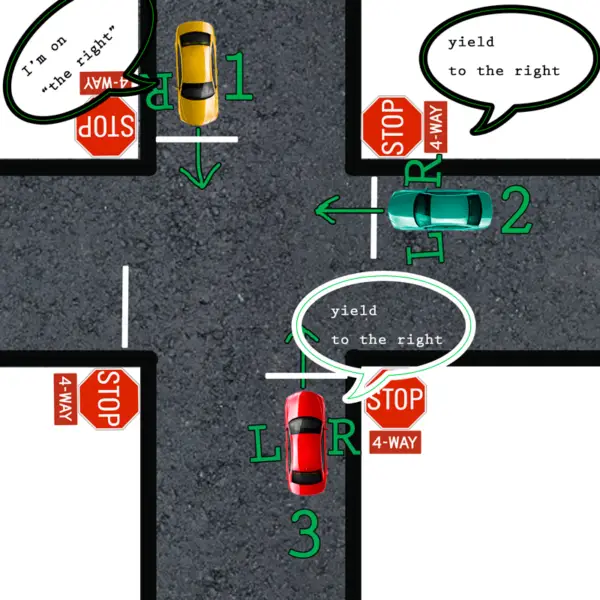
Sometimes There Is a 5-Way Stop
The 5-way stop works exactly like the 4-way stop (and the 3-way stop, and the All-Way stop)
That means:
- Whoever stops first, should go first.
If you stop at the same time:
- Yield to the vehicle on your right
- Left turns yield to right turns
- Left turns yield to straight traffic
When unsure, use courtesy. Now, hopefully, you’re feeling much better about the magic and fun of mastering the 4-Way-Stop Intersection in Canada and the U.S.
Traffic Lights Out?
If you’re driving and find an intersection that has traffic lights that are not working, treat it as a 4-way stop intersection. Be extra careful, of course.
Who Has Right-of-Way at 4-Way Stop in Canada?
Technically speaking (and this is my driving instructor brain talking here) nobody “has the right of way” until another driver has clearly given it; or in other words, yielded. Whoever stops first should go first, whoever stops second should go second, and so forth. If you stop at the same time, yield to the right. If you stop at the same time, left turns should yield to right turns and straight through traffic.
What is The Difference Between All Way And a 4-Way Stop?
4-way stops and all-way stops work the same way, where every driver must stop and take their turn. The only difference sometimes is that there may be a different number of roadways than four.
The all-way stop is a clear indication that all road users must stop, regardless of the number of roads. In many instances, there is absolutely nothing different between the all-way and four-way stop. Let’s take a look at an example from North Vancouver.
There are basically two four-way stop intersections right beside each other due to the divided (boulevard) roadway. So, instead of having eight stop signs that say 4-way stop, they indicate it is an all-way stop. But there are still two all-way stops beside each other. It just lets drivers know that everybody will be stopping.
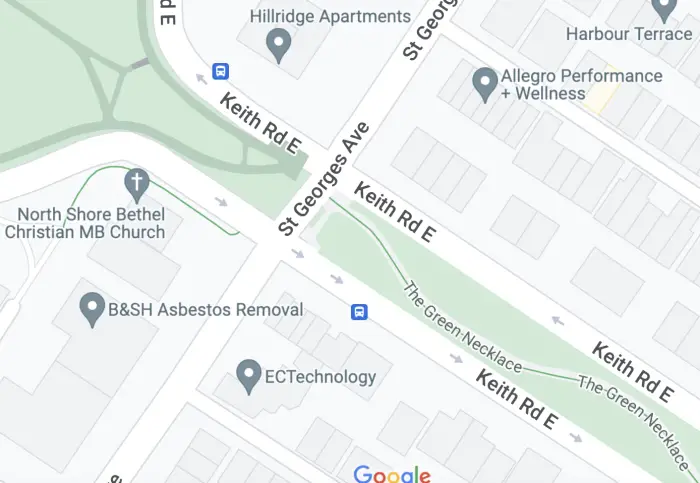
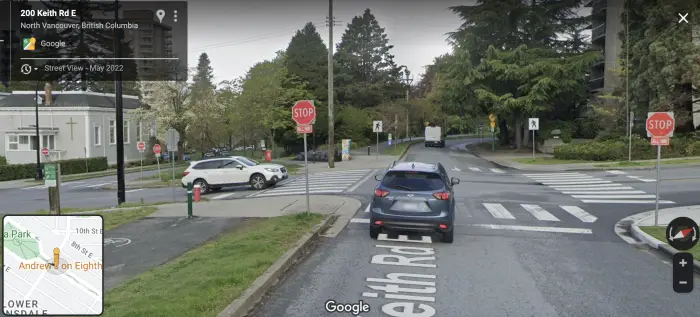
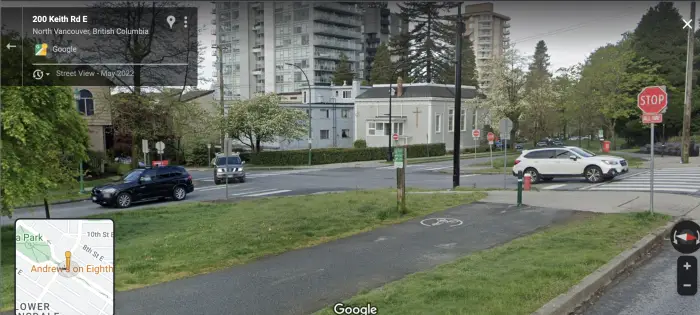
Conclusion
If you’re new to Canada or the U.S. or new to driving, you may be encountering a four-way stop for the first time. How exciting! Don’t worry because they aren’t that bad. In fact, they seem to be easier, quicker, and dare I say more fun compared to 2-way stops.
2-way stops can be difficult and time-consuming because you don’t just “get your turn” like in the 4-way stop. Often, there are visibility issues and other issues making your life difficult.
Just be careful at four-way stops because sometimes, a car is going straight with its turn signal on. Or, it’s turning without a signal. Or, someone doesn’t see the stop sign and keeps driving through the intersection at full speed, which is of course scary.
You can’t just trust people’s turn signals, even though that would be nice, and even though the point of a signal is to tell other people what you plan to do. If you’re ever not sure if it’s safe to go at the same time as another car, simply wait. It’s what a defensive driver does.
Check out the four-way stop video on this page and let me know in the comments what your biggest concern is about the four-way stop intersection. Be sure to check out the articles on turning left, turning right at a traffic light, and turning right on a red light.
Question from Melanie
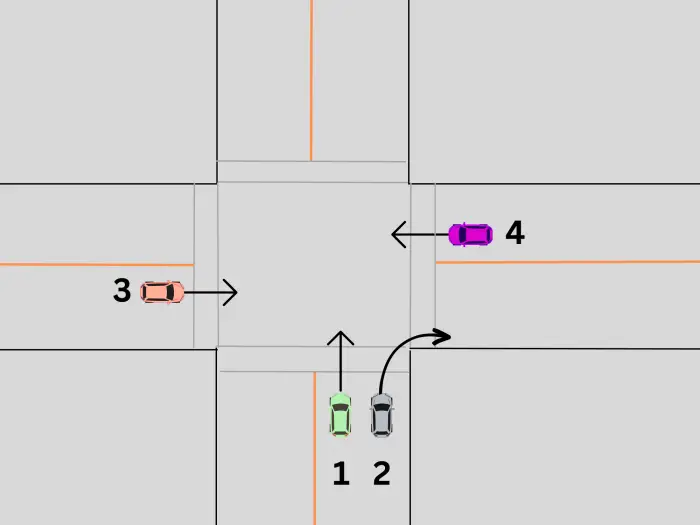
The question is: Two cars (1 and 2) travelling north – one in the right lane intending to turn right (east), a third (3) traveling east, a fourth (4) heading west. Order of arrival: car 1,3,2,4. This gets even crazier when busy, with no end to the lines of cars arriving in all lanes and you can barely tell who of the 8 cars is first. then add the pedestrians!
In this case is the order: north bound car 1, east bound car 3, north facing, right turning car 2, west bound car 4?
Yes! I believe Car 2 should yield to Car 3, because Car 3 stopped before Car 2. The presence of Car 1 isn’t a magical “you may also go” ticket.
Or, can the right turn (car 2) go when car one goes (because they arrive at the stop very close together and car three is heading straight through. What if car three is turning left?)
If Car 3 is turning left and Car 2 is turning right, these can certainly go at the same time. You just need to be sure – if you are Car 2 – that Car 3 is actually going to turn if it has a left-turn signal on (never trust people’s turn signals automatically).
The cars are not going to use the same chunk of pavement, so they have no potential conflict. They can turn at exactly the same time and be happily on their way.
The only issue is when people don’t signal and then turn, or use the wrong signal, then crashes can happen, so we do need to be cautious.
Or, can the right turn (car 2) go when ever they have stopped and can turn safely?
Whenever there is no conflict is fine in my opinion. Otherwise, wait their turn and go in order. This is all about which car(s) will be needing to use the same chunk of pavement at potentially the same time. If no potential conflict exists (if you aren’t “taking someone’s turn” or bothering anyone) go for it. Driving is a brain game.
Check out this article on a similarly confusing 4-way stop with additional stop signs in Caulfield, West Vancouver.
Related articles:
